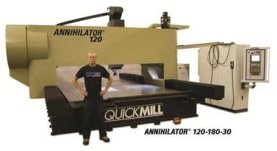anchorman
Titanium
- Joined
- Dec 19, 2005
- Location
- Opelika, AL
We're looking at a couple of new machines for the shop I work in, and trying to get some real world info regarding ball screws vs helical rack. Which is better for wood?
The companies selling machines with helical rack on the X/Y axes argue that there is the issue of whip on long ball screws, but the designs I've seen using ball screws on X/Y have the ball screws stationary and the nut is integrated into the motor. Hard to see how one would have a problem with the screw length due to it rotating, when the screw itself is not rotating. Sag might be a problem, but given that the distance between the motor, screw, and the rails is fixed, I can't see that being a huge issue in use, except for it possibly causing wear to the screw over time.
Argument that the rack gear manufacturers make against ball screws is that they are actually less accurate over the distances involved in a CNC router designed for 4'x8' pieces of plywood and larger. It seems they are assuming in this argument that the ball screws themselves are rotating to cause movement, but maybe I'm misunderstanding?
If anyone else has experience/insights, and can help me cut through the marketing jargon, I'd appreciate it!
The companies selling machines with helical rack on the X/Y axes argue that there is the issue of whip on long ball screws, but the designs I've seen using ball screws on X/Y have the ball screws stationary and the nut is integrated into the motor. Hard to see how one would have a problem with the screw length due to it rotating, when the screw itself is not rotating. Sag might be a problem, but given that the distance between the motor, screw, and the rails is fixed, I can't see that being a huge issue in use, except for it possibly causing wear to the screw over time.
Arguments in favor of helical rack are that it is usually the spur gear that is designed to wear, and it is easy and cheap to replace.
Arguments against helical rack are backlash issues, and keeping the rack itself clean... the cleaning part is a huge pain in the arse in my experience. I imagine running with some cleaning solvent is much easier on a ball screw, than trying to get every nook and cranny of a rack gear clean.
Arguments against helical rack are backlash issues, and keeping the rack itself clean... the cleaning part is a huge pain in the arse in my experience. I imagine running with some cleaning solvent is much easier on a ball screw, than trying to get every nook and cranny of a rack gear clean.
Argument that the rack gear manufacturers make against ball screws is that they are actually less accurate over the distances involved in a CNC router designed for 4'x8' pieces of plywood and larger. It seems they are assuming in this argument that the ball screws themselves are rotating to cause movement, but maybe I'm misunderstanding?
All the machines claim +/- 0.001" *repeatability* - What I understand that to mean is that they will return to the same spot on the table within that range. Cutting forces involved will affect actual cut accuracy beyond that, i.e. deflection of the bit, deflection of the machine, etc.If anyone else has experience/insights, and can help me cut through the marketing jargon, I'd appreciate it!




